Toggle Background Color
For this introductory game, I'm going to be playing a single spirit, with a single island segment to defend. The game really shines with the interaction between multiple spirits, but trying to keep track of everything happening with multiple spirits in play would make things considerably harder to follow, so until we're into the swing of things I'm going to be showing things off with individual spirits.
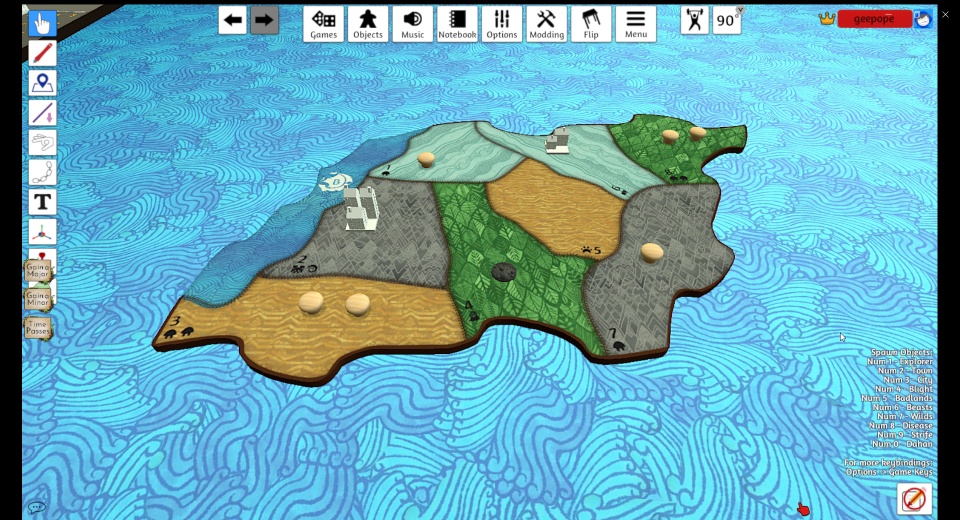
So here's our starting island. It's still primarily inhabited by its indigenous people, the Dahan, whose settlements are represented by rounded wooden hut pieces. The invaders' shiny white pieces have a town in the island's interior and a city on the coast, but haven't been rocking the boat much so far.
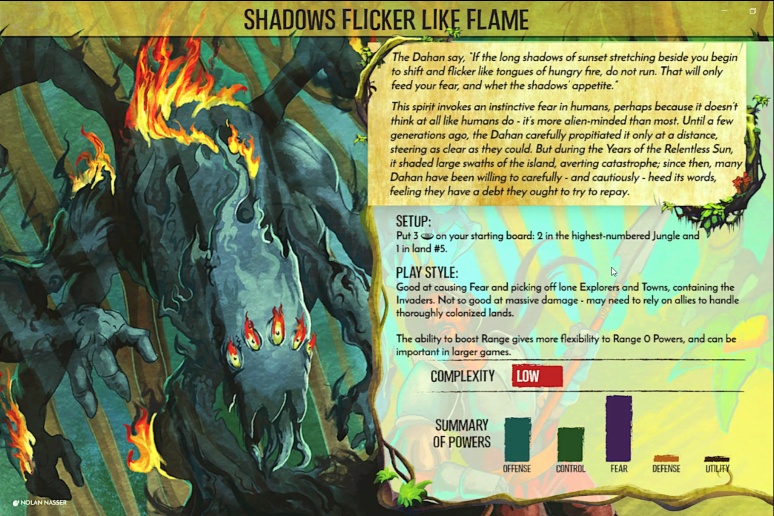
That's about to change. The invaders are ramping up their efforts, awakening the island's fearsome protector in response. Shadows Flicker Like Flame is a little unusual in that rather than the embodiment of a natural phenomenon it's the embodiment of an unnatural phenomenon. (It's also maybe a little bit weaker than most of the spirits in the game, but we're playing at the introductory difficulty level so that's not even going to begin to be a problem.)

We keep track of what the invaders are doing here on the invader board, which tracks most of the game state information (and also miscellaneous piece storage) beyond what's physically on the island. The most prominent feature here is the fear deck, which this TTS mod helpfully expands so that you can see exactly how many cards are left at each terror level; this deck represents the invaders' resolve, and as they get spooked the fear deck will deplete and they will get closer to abandoning the colony. But the most important part of the invader board are the boxes at the bottom for the invader action cards, the first of which has flipped to reveal jungle terrain.
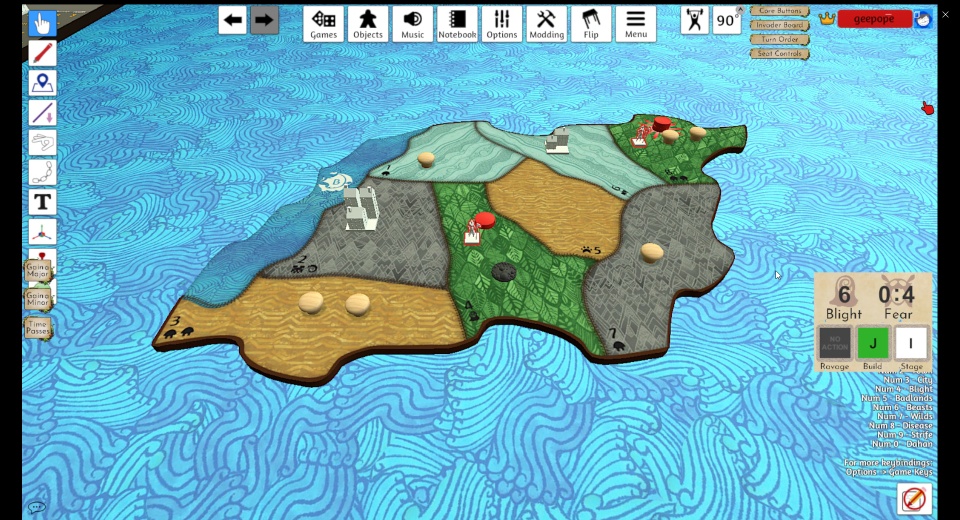
As a result, the invaders send their first explorers out into the jungles. The island is divided into four different biomes: Mountain, Jungle, Sands, and Wetlands (there is also a designated ocean, marking the most accessible coast for invaders to land in, but most of the time it is not relevant beyond that.) Each turn the invaders focus their efforts on particular biomes represented on the invader cards, which they will ruthlessly exploit over the course of a few turns. Now all three sizes of invader piece are present: Explorers, Towns, and Cities. Explorers are the weakest and most common, and are only directly dangerous in groups. But the presence of Explorers can allow invaders to build towns, which are tougher although still fairly manageable. Cities are the rarest and most dangerous of all: outside of the starting city they only crop up in lands that are already settled with towns, and once they're there they are quite tough to deal with.
I've enabled the invader board HUD off to the right, so we can see most of the important bits of the invader board without having to look off to the side. We can see that now that the invaders are done exploring, the jungle card has moved over to the Build box, queuing up the invaders' next action. There are also trackers for the amount of Blight remaining (thinking of this as the island's health) and the Fear token pool, representing progress towards earning fear cards.
The red checkers on the board are our presence: the spirits do not occupy physical space as we think of it (and Shadows Flicker Like Flame has an even more tenuous connection with physical space than most) but they are connected to certain places of power where their influence is strongest. The more distant jungle has two stacked checkers (with a helpful burst graphic inserted by TTS for identification), making it an even more powerful Sacred Site and giving us even more options there. You could theoretically have more than two presence there, but in most cases there's no benefit to adding more: either you have a Sacred Site or you don't.
In our present state, there's not a lot we can do to affect the island and we're horribly outmatched by the invaders. The first task each turn is to grow our spirit's power and choose our development path. But first, let's take a look at what we're working with.
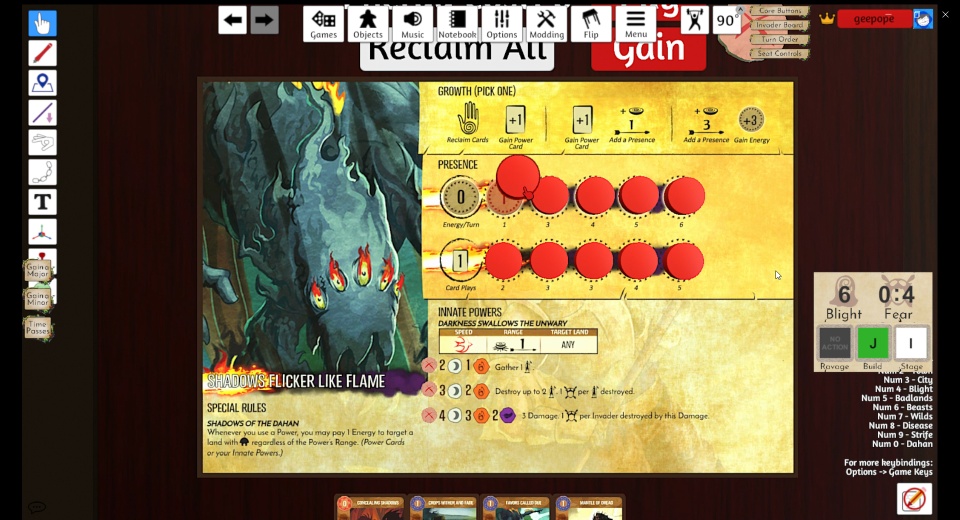
Here's the spirit board for Shadows Flicker Like Flame, which covers all the crunchy mechanical bits. There's a lot to cover here.
Most prominently, in the middle of the board there's a row of additional presence checkers covering up two tracks representing our basic resource capacity. As part of our growth we can move presence from our tracks to the board, which simultaneously expands our reach and uncovers additional resources. Right now we can only play 1 card per turn and generate 0 energy to pay for cards... which, given most cards cost energy to play, is a problem! By placing a presence we could uncover the next spot on either track, moving up to 1 energy/turn (shown here) or 2 card plays/turn depending on which track we took presence from.
We can do that by using the growth options displayed above the spirit tracks: at the start of every turn each spirit gets to pick one bundle of goodies from those listed here. The first option would reclaim cards from our discard pile (not relevant right now, obviously) and add a new card to our hand. The second option also adds a card while placing a presence from our tracks; the range arrow labeled 1 means we could put the new presence down anywhere up to 1 land away from any of our existing presence. Lastly, we could also place a presence with longer range and get an immediate one-time burst of 3 energy.
In the lower right is our special rule, Shadows of the Dahan. This lets us boost the range of our powers at a cost of energy. It's handy, but situational and kind of expensive, especially in a solo game where distances are small.
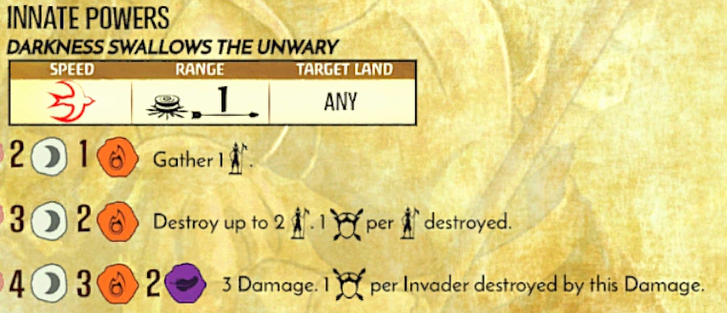
Finally, we have our Innate Power. By playing cards with matching elements we can unlock an additional bonus power for free. Innate powers help shape a spirit's playstyle and steer their elemental preferences when picking new cards. We'll go over this in more detail later, but the main takeaway is that Shadows Flicker is very good at manipulating (and later destroying) explorers.
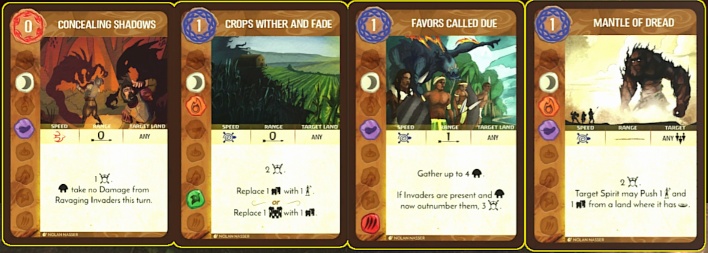
Lastly, let's take a look at our starting cards, the powers we use to combat the invaders. Along the right hand side you'll notice various colored symbols: the cards you play provide these elements which you can match into sets to meet thresholds for innate powers. These aren't a resource that are spent, things that care about element thresholds simply look to see if you have that many in play or not. From top to bottom, the 8 elements are Sun, Moon, Fire, Air, Water, Earth, Plant, and Animal. Shadows Flicker is very heavily based on Moon powers, followed by Air and Fire with a few odd elements available to round things out. You'll notice that our starting elements are not a perfect fit for the elemental requirements on our innate power, which can be frustrating at times.
Generally, powers target a single land that must be within a given range from one of your presence markers (although some powers target spirits directly, rather than the board.) A lot of our starting powers are range 0, which makes targeting quite tricky as they only affect the few lands we have presence in. The Shadows of the Dahan special ability helps here, but it's very taxing on our energy at this stage of the game.
Looking at the effects themselves you may notice that they all have the same stylized screaming face symbol from the fear tracker on the HUD, indicating that they generate Fear tokens. Not all possible powers necessarily generate Fear, but Shadows Flicker is pretty creepy.
As far as the individual cards, from left to right:
Concealing Shadows does virtually nothing on its own besides a single fear, but it does protect Dahan from ravaging Invaders. This is important, as Dahan that survive combat can counterattack for quite a bit of damage. This makes Concealing Shadows a deceptively huge part of our offense, although its range can make it painful to set up.
Crops Wither and Fade is notable in that it's the only card we have that can directly remove towns and cities. Removing cities is potentially very important, although leaving a town behind limits its usefulness. But sometimes it's easier to downgrade a city and deal with the town than it is to deal with the much more durable city.
Favors Called Due masses a whole bunch of Dahan into a single land and can conditionally generate a whole bunch of fear. The Dahan are generally passive and on its own this doesn't do much, but it can set up Concealing Shadows or other powers.
Mantle of Dread lets you evict a couple invaders from a single land with your presence. In games with multiple spirits/players you can play it on someone else to target lands with their presence instead, but on a solo island it's basically just another range 0 power.
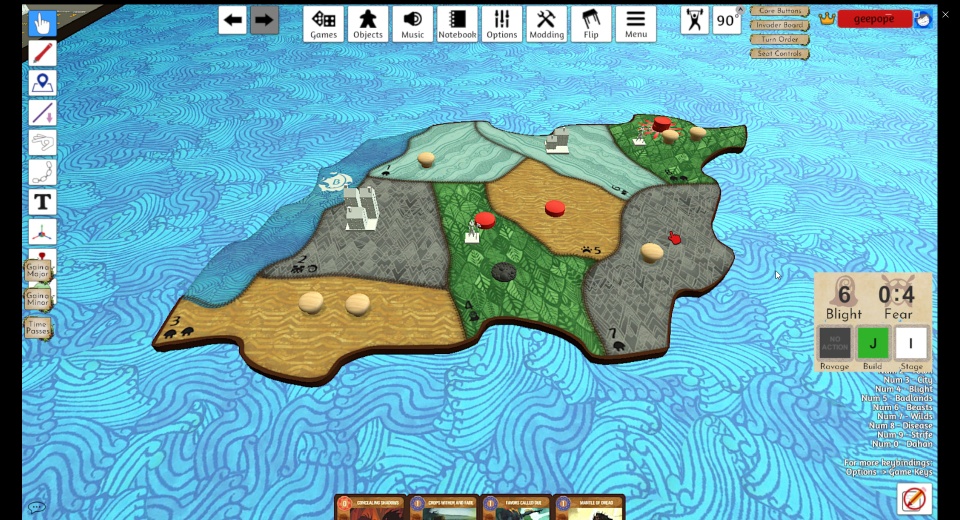
We need to pick one of the growth options from our spirit board, but first let's run down our strategic goals. At the outset there are two ways of winning the game: either wipe out all the invaders, or generate enough Fear to empty the fear deck. But you can also sort of mix-and-match, as the threshold for the invader-elimination goal gets progressively relaxed as you go through the fear deck and reach new terror levels. Until we reach one of those objectives, we have to limit the damage the invaders do before they cause enough Blight to damage the island's ecosystem beyond repair.
Our only 0-energy card doesn't do anything until the invaders start ravaging next turn, so we need energy from somewhere to afford anything useful. I could take the third growth for a quick energy infusion, but instead I opt to uncover the 1 energy/turn space and draw a new card. I place the new presence in the other jungle: it already starts with a blight piece (the black bubbly thing), so protecting it from further damage is definitely going to be a priority.

When you gain a new power there are two decks you can choose from. Minor Powers are cheaper but less powerful, costing no more than 1 energy apiece. Major Powers pack a much bigger punch but cost big energy, and simply picking up a major power carries an additional cost of having to permanently lose one of your other cards. So for right now, picking up a minor is a no-brainer.
Gaining a power from either deck uses a draw 4, pick 1 rule (there is an option for new players that gives each of the 4 starter spirits specific draws, but I've never used it even in newbie games since drafting powers is just too fun and important.) There are some solid options here but Veil the Night's Hunt is the best fit for our innate elements, and should be useful in its own right. On its own the damage is only useful for taking out explorers since they're the only thing that can be killed with a single point of damage, but that combos nicely with Shadows Flicker's native explorer control, and being able to maneuver Dahan is also valuable: we have Favors Called Due to set up a big pile of Dahan, but it lacks the ability to fine-tune Dahan positions.
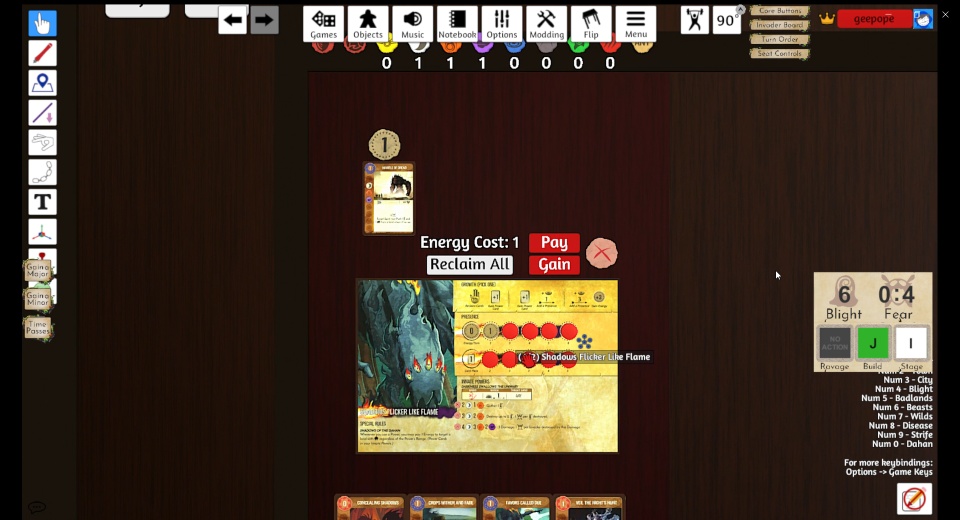
We're still only at 1 energy and 1 card play per turn. Mantle of Dread will let us evict the invaders from either of the jungles where we have presence, so that's our play.
However, it's not as simple as playing Mantle and kicking out an explorer. Powers come in two different speeds, fast (red) and slow (blue). Fast powers go off before the invaders act for the turn, slow powers go off after the invaders (but still have to be played & paid for at the start of the turn.) The spirits act on a much longer time scale than humans do and are often left scrambling to keep up, so by the time Mantle of Dread activates there will be more invaders on the board.
Thanks to our card draw we do have the option of preempting the invaders with Veil the Night's Hunt, which could let the Dahan in the inner corner clean out that jungle at fast power speed. But the already-blighted jungle is a higher priority, so I'm sticking with Mantle for now.
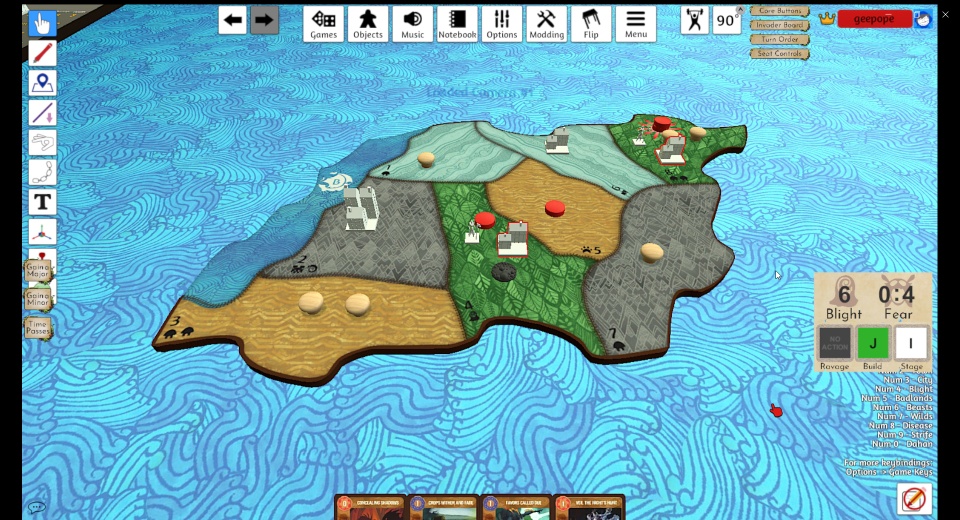
Since we have no fast powers in play, we skip straight to the invader phase. Invaders act according to the schedule laid out on the invader track: the jungle card is showing in the build phase, so every occupied jungle will pop out additional settlements this turn.

After the invaders build, they immediately explore a new terrain, adding explorers to each Wetland... and then all visible terrain cards slide over. Next turn, the jungles that just built will ravage, potentially devastating the land and its native inhabitants. The newly explored wetlands will build. A new terrain card will be drawn and invaders will explore there - and then the turn after that it will be the wetlands ravaging, the next terrain building, and so on. The invaders' march of progress is relentless.
So let's do what we can to throw a wrench in it. Mantle of Dread can push both a town and an explorer out of one of our lands...
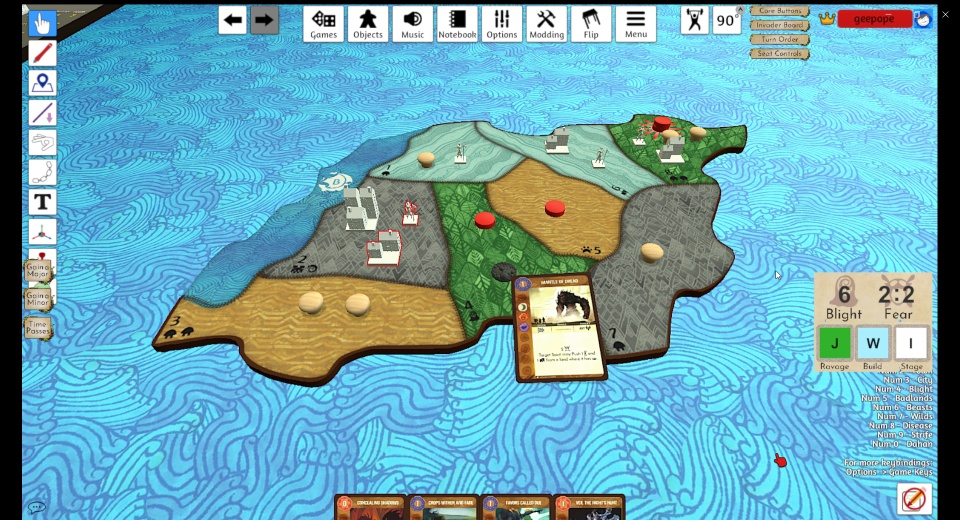
...so we send them fleeing our spooky jungle into the safety of the coastal mountains. It's your choice where to send each individual pushed piece, but generally speaking consolidating threats tends to be the best option as long as you're not exacerbating an immediate problem. Mantle of Dread also earns 2 fear, getting us halfway to earning our first fear card.
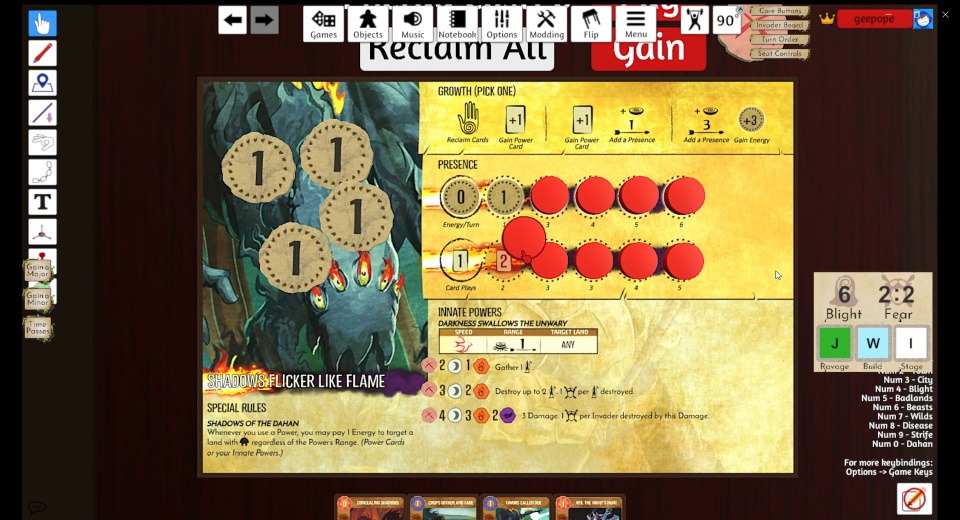
That's our only power in play, so that's it for turn 1 and we start the next turn with another growth phase. The board's in notably worse shape, with twice as many settlements in play. That's pretty typical: most spirits struggle to keep up in the early game, so it's a matter of playing damage control while you work on growing up to speed. At least this turn we can better afford to ramp up to 2 card plays, giving us a lot more options to work with.
So, thinking about our strategy. The second jungle is still going to ravage this turn, causing that town and explorer to do damage to the land and also the resident Dahan. Explorers do 1 damage, towns do 2 damage, and cities do 3 damage. All it takes is 2 damage to add blight, which will destroy some of our presence there and drive us closer to our loss conditions (not only do you have a finite amount of blight you can suffer before losing, if any spirit's presence is wiped out it's an instant game over.) If blight is added to a land with preexisting blight, it cascades and adds yet another blight in an adjacent land. So it's particularly important to keep blighted lands from being damaged further.
Every 2 damage also destroys 1 Dahan, and this damage is applied simultaneously with damage to the land. We could play Concealing Shadows and protect the Dahan there... but saving 1 Dahan is a pretty piddly use of an important card. Regrettably, we're just going to have to leave them to fend for themselves. And all of our other cards cost energy, so to get enough energy to play 2 cards we're going to have to take the 3rd growth option for an infusion of +3 energy.
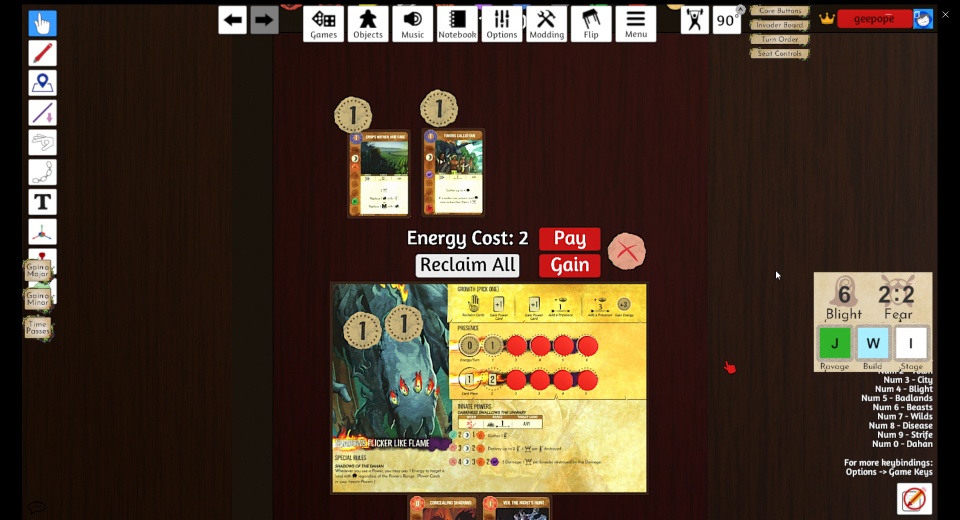
Where does that leave us? Now that we have 2 card plays it would be really nice to trigger our innate, which means we need 2 Moon element and 1 Fire. All of our cards have Moon, so that's easy, but the only way to get a Fire is by playing Crops Wither and Fade. We're also running low on cards and will probably be playing Concealing Shadows next turn, so we want Favors Called Due in order to set it up. That leaves us 2 left over energy (after our normal income of 1 energy + 3 extra energy from growth) which we can save for next turn.
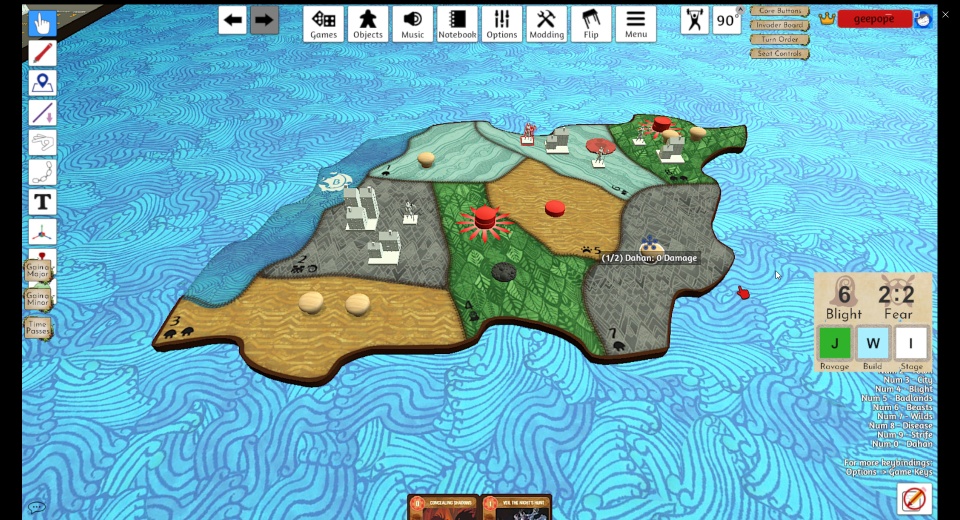
Thanks to the elements on our cards we unlock our innate, Darkness Swallows the Unwary. It's a fast power, so we can use it before the invaders take their actions. The stacked presence on the range icon indicates that we need a Sacred Site to use it; our starting site should work, but we'll put another presence in the other jungle to build a sacred site there for future use. Gather is the opposite of push, moving pieces into the target land from adjacent lands. So we can target the inland wetland and yank the explorer out of the nearby coastal wetland, consolidating the invaders further.
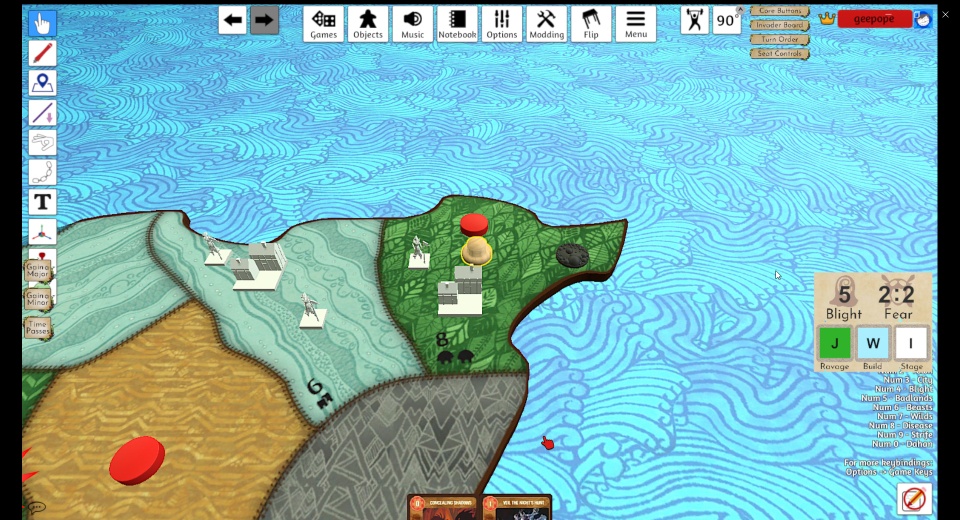
Then it's the invader phase. First, the invaders ravage in the jungle. One of the Dahan is wiped out, and the other is wounded (shown by getting flipped upside down.) We're in the same boat, losing one of our presence to blight as the invaders cut their way through the fragile forests.
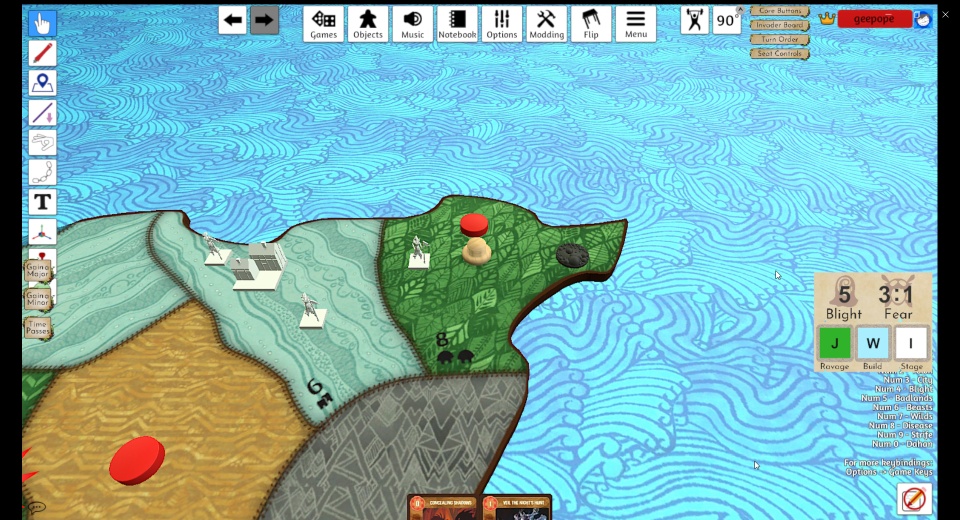
The upshot is that the surviving Dahan get to counterattack. Like invader towns, Dahan villages deal 2 damage each--enough to destroy the town in retaliation (normally, all invader and Dahan pieces have health equal to the damage they deal.) Destroying towns through any means automatically generates 1 fear per town (and 2 per city), so this banks us another fear.

After ravage, the invaders build again. Invaders only build in lands that already contain invaders, so by preemptively emptying the coastal wetlands we stopped the build altogether. But the interior wetlands already have a town, so they build a shiny new city. That's... not great news. Worse, the invaders are exploring into mountains next, so that big pile on the coast is going to be a problem sooner rather than later.
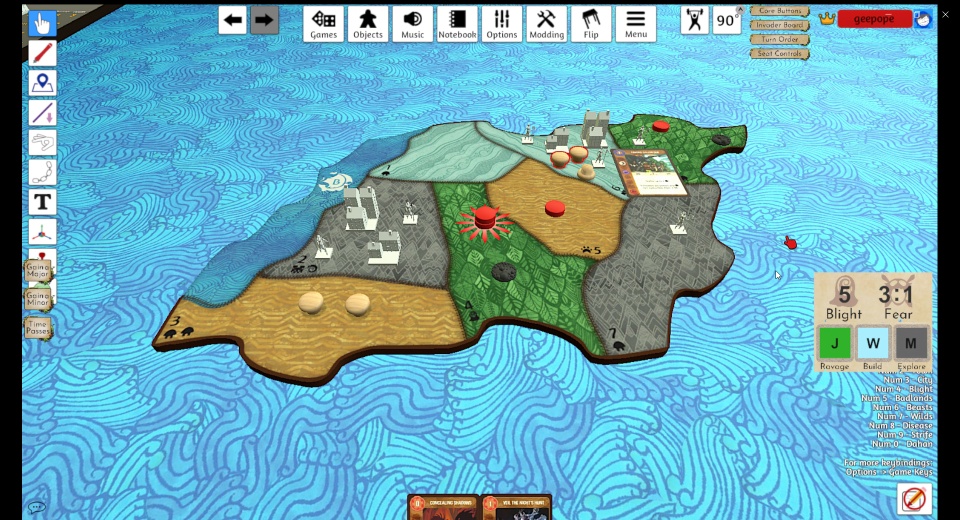
That's it for the invaders this turn, at least, so now time for our slow cards. Favors Called Due gathers the scattered Dahan into the wetlands, although the casualties from this turn's ravage means they're not able to get the bonus fear from outnumbering the invaders. Damage wears off at the end of the turn, so the wounded Dahan village will be back to full health next turn--not that it matters, since we will be able to use Concealing Shadows to keep it safe regardless.
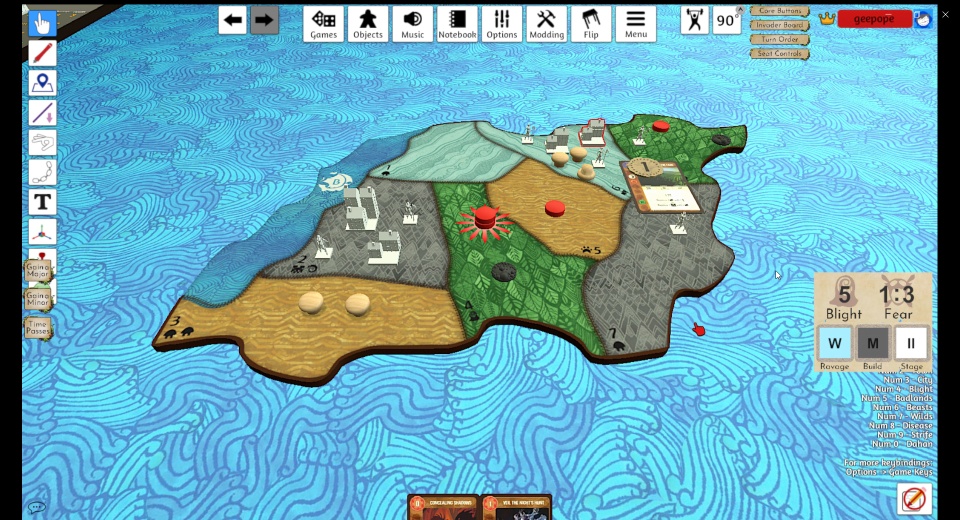
Crops Wither and Fade has a range of 0 and can only target lands with our own presence, but there aren't any towns or cities for us to target. Our special rule lets us pay 1 energy to target the wetlands now that there are Dahan there. Honestly the better play would probably be to play it on one of our empty lands just for the fear, but for demonstration purposes why not? That knocks the city down to a town and nets 2 fear (note that the city did not actually get destroyed, so the only fear we get is what's explicitly printed on the card.) Upon earning a total of 4 fear, we get to draw a Fear Card. This card will come into play before the invaders' next action and trigger some small random bonus for us. Fear cards start out generally quite weak but as you get towards the bottom of the deck they ramp up as the colonists get more superstitious about the unnatural spirits haunting the island. Progressing through the fear deck also advances us to higher Terror Levels.

Next up, time for growth. We have 1 energy left over and will earn another energy this turn, and our two remaining cards only cost 1 energy between them, so if we pick up another minor power we should be able to boost our card plays again and play all 3 (nothing in the minor power deck costs more than 1 energy.)
Sadly, none of the cards drawn have a fire element, so we actually won't be able to trigger our innate this turn. I glossed over the first power card draw, but now that we've seen a bit more of the game I should probably cover what some of our options do:
Uncanny Melting can remove 1 blight from a sand or wetland, which both nips potential cascades in the bud and replenishes the pool of blight. We do have wetlands that are about to get blight but it's not really going to be a priority, and the measly 1 fear on it isn't really enough to make it worthwhile.
Dark and Tangled Woods is pretty nice: it's got a decent chunk of fear, and gives us a source of Defend. Defend effects reduce the total damage from a ravage, potentially preventing blight/Dahan deaths. But Shadows Flicker generally relies on using pushes to deal with small ravages and Dahan backed by Concealing Shadows to deal with big ravages, so having a smallish Defend doesn't really fit into our game plan that well.
Encompassing Ward is a rare wide area effect Defend, but it runs into the same problem as above, compounded by the fact that it only affects lands with our presence--which are currently clear, and tend to remain clear since we have multiple range 0 powers to deal with them. Coupled with the complete element mismatch and lack of fear and it's a hard pass.
Delusions of Danger is somewhat redundant with our innate power, but since we don't have the elements to trigger our innate power this turn it's an appealing replacement. It can also be used just for raw fear, although 1 energy for 2 fear isn't a great deal.
So Delusions it is. That does mean all of our energy will be spoken for and we won't be able to afford the range boost from Shadows of the Dahan, so if we want to use range 0 Concealing Shadows in the ravaging wetlands we will have to place presence there ourselves (this is another reason Encompassing Ward is unappealing, since Shadows Flicker will often have its presence placement dictated by its range needs and can't often afford to plunk down a presence just to add a very minor defend.)

Veil the Night's Hunt can push these Dahan into the coastal mountains to help deal with next turn's ravage. Next, Delusions of Danger sends the explorer fleeing out of the inland mountains. Concealing Shadows also pops an extra fear and protects the Dahan in the upcoming big wetland ravage; I'll put a reminder marker there to note that Concealing Shadows is in effect.

Before the invaders act, we get to reveal the fear card we earned for a one-time boost. Each fear card has 1 of 3 possible effects; we start out at Terror Level I, so we only get to use the weakest top effect. Which means Delusions of Danger was largely redundant since the fear card would have let us gather up that explorer anyhow. Instead, I opt to consolidate the explorer left in the jungle into the wetlands; the jungle explorer wasn't going to do much anytime soon, but the fewer stray invaders there are scattered about the better.

And now the big ravage. Despite the big pile of invaders, each ravage normally can only blight once no matter how much damage it does. That knocks out my presence, but Concealing Shadows lets the Dahan all live to counterattack. Three Dahan x 2 damage a pop = 6 damage, enough to knock out 2 towns (2 health each) and 2 explorers (1 health each.) That wipes out a good chunk of invaders and the fear from destroying both towns earns another fear card in the process. The invaders have already started acting, so the new fear card will get triggered next turn.
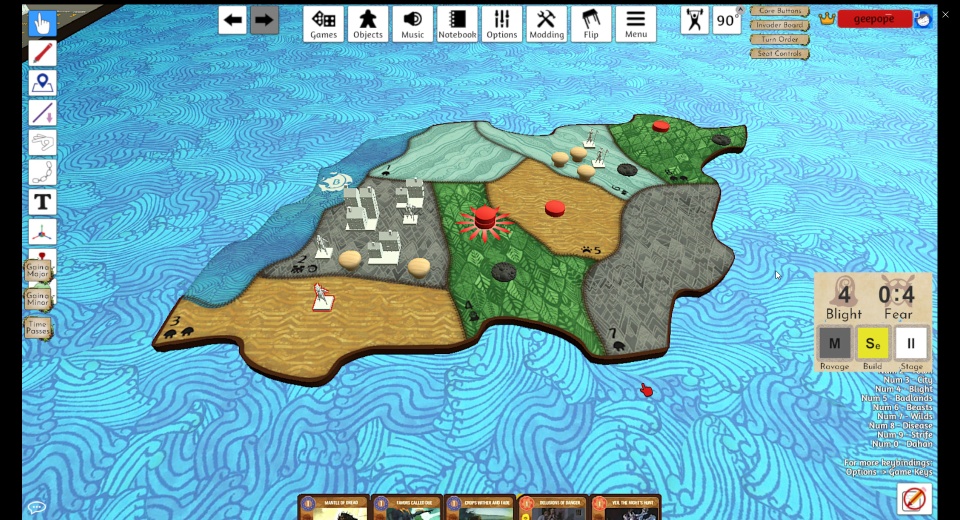
Again, only one land builds as the interior mountains are empty. Invaders explore in sands next--but this time we get to leave the interior sands empty. Invaders can only explore where there's an adjacent town, city, or ocean, so if you can knock them out of the interior you get some breathing space.
It may seem obvious that sands were the next exploration since they were the only biome left, but as it happens that was just luck. The invader terrain deck is composed of three stages (labeled I, II, and III) with their own sub-deck. The first stage has only 3 randomly chosen cards, so this turn's stage II card is drawn from a separate pool. If we were really unlucky we could have run into mountains again.
(The e subscript on the sands card can be ignored for now--it's a feature of stage II cards that will only come into play at difficulties beyond the introductory level.)
At any rate we have no slow powers in play, so it's time to grow again. But as we have no cards left in hand we're forced to reclaim our cards from the discard. This also lets us draw a new card, but the reclaim option does not get to place any presence, so we'll have to make do with the plays and energy we have.

Our card draw has multiple 0 cost powers, which is going to be very important.
Call to Isolation might be appealing if we hadn't already found Veil the Night's Hunt: it's weaker and doesn't have the vital Moon element, but it's free.
Visions of Fiery Doom is both good and bad for us. It's got the right elements and giving fear + invader manipulation at range 0 plays to our strengths... which also makes it sort of redundant a lot of the time.
Shadows of the Burning Forest runs into similar issues and adds some targeting restrictions, but it's another freebie.
Gift of Power is intriguing: it doesn't do anything for us right away but it would let us immediately draw a new power to use next turn, and has a wide element spread that at least includes Moon. But we need Moon+Fire to activate our innate, so Shadows of the Burning Forest is a must-have here.
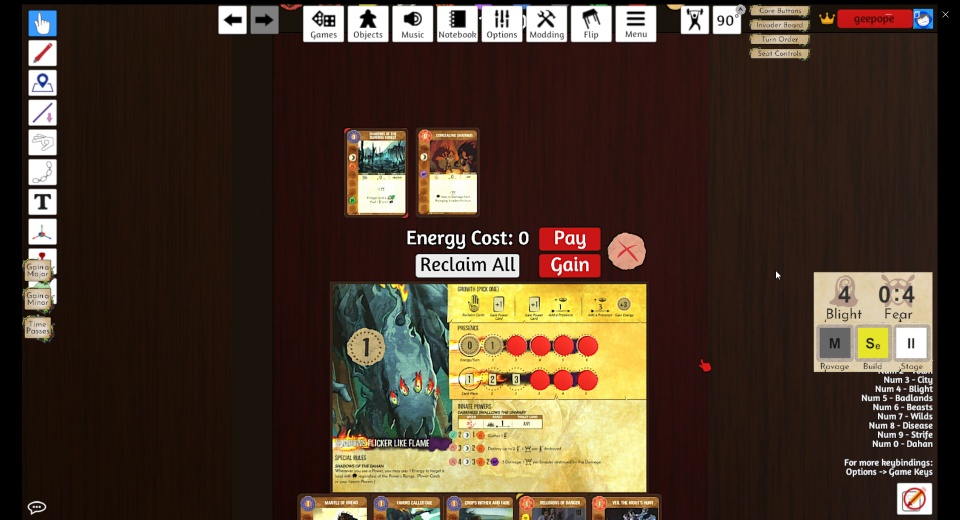
Even though we have enough energy to play a 3rd card, I really, really want to play Concealing Shadows for this turn's mountain ravage--but the only way to reach it is to pay energy for Shadows of the Dahan. So we're going to sit pat with just our two cheap cards this turn and skip the 3rd card play. Leaving resources on the table like this is pretty painful and often means you got sloppy somewhere, but we're playing at a low enough difficulty that it's not a critical problem.

We still have just enough elements to power our innate, letting us draw out the explorer from the coastal sands before it can build. Then we pay 1 energy to activate Shadows of the Dahan to get Concealing Shadows on the mountains.
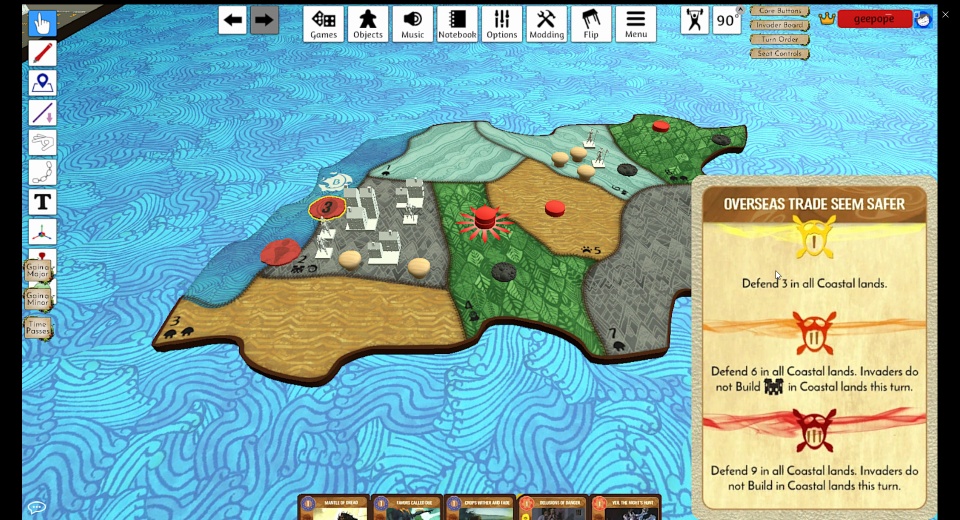
This turn's fear card flip is semi-relevant as we are facing a coastal ravage, but unfortunately there are just too many invaders. Each point of Defend reduces the total damage dealt by invaders by 1, and defend 3 just isn't nearly enough to bring this big pile under the critical threshold of 2 damage. This is why I had no interest in Dark and Tangled Woods even with a mountain ravage coming up; even if I had taken it and stacked it with the defense from the fear card (that I had no way of knowing was coming), I'm looking at 11 damage from these invaders, so even defend 6 (let alone defend 3) would leave the land blighted and the Dahan wiped out.
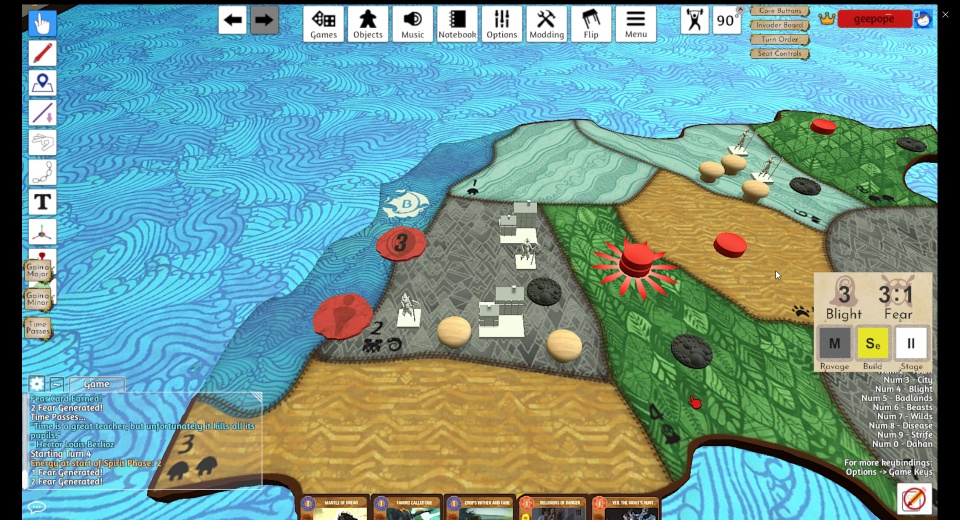
The upshot of paying to use Concealing Shadows at range is that it means our presence is safely elsewhere, so although we add another blight we don't have to worry about losing any presence. With the 3rd blight we've taken, we're halfway through the blight pool and will have to be cautious about additional blight: a single cascade will almost wipe us out.
The two Dahan are safe to counterattack, taking out a city for an easy 2 fear. The leftover damage picks off a measly explorer: while taking out buildings is generally higher priority, invaders also return to full health at the end of the turn so there's not much point sticking nonfatal damage on towns if you don't have more damage coming.
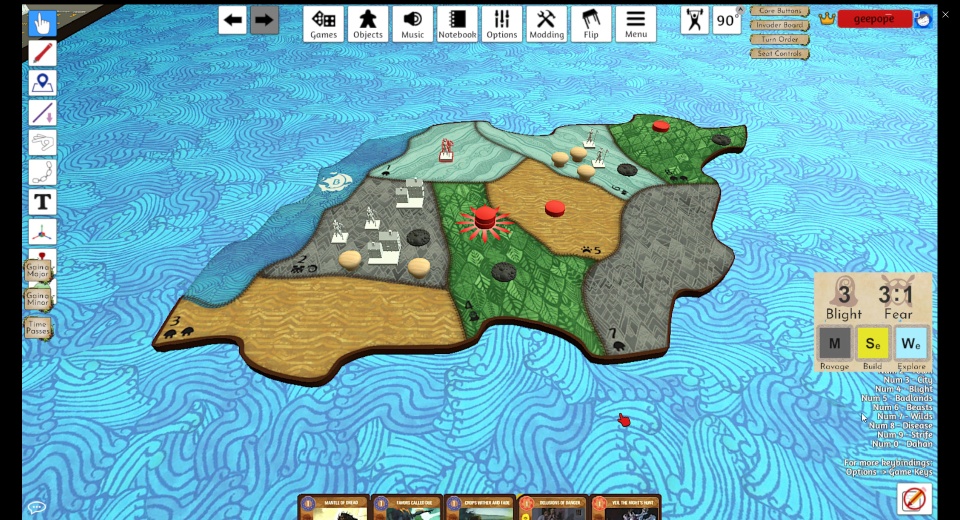
With both sands empty, the invaders build absolutely nothing this turn which makes next turn's ravage a freebie. Wetlands come up again next; the inland wetland can't be explored as it has no adjacent settlements or oceans, but unfortunately it already has explorers left over from the last cycle.
Unfortunately, Shadows of the Burning Forest can only target a land with invaders. Our only surviving presence is in empty lands and we don't have any energy left to pay for a range boost, so slow phase is a dud. That hurts, but at least it didn't cost any energy, and the elements it gave us let us use our innate to save one of the sands from a build.

Growth time. We've reached the point on our card plays track where progress slows down, but our energy track jumps from 1 energy/turn to 3, so our next growth is obvious. There's not much point in taking extra energy on top of that, so we pick up a new minor to pad our hand.
Devouring Ants isn't too shabby for damage, but its elements are useless to us and we don't need to care about jungles or sands at the moment.
Steam Vents has a Fire we need, but we already have issues trying to target all our range 0 powers.
Gift of Living Energy is another support power, giving us some extra energy to play with for future turns and more importantly providing Fire.
Gnawing Rootbiters is a decently strong control effect with awful elements, and we really want Fire for our innate, so Gift of Living Energy looks like a better bet.
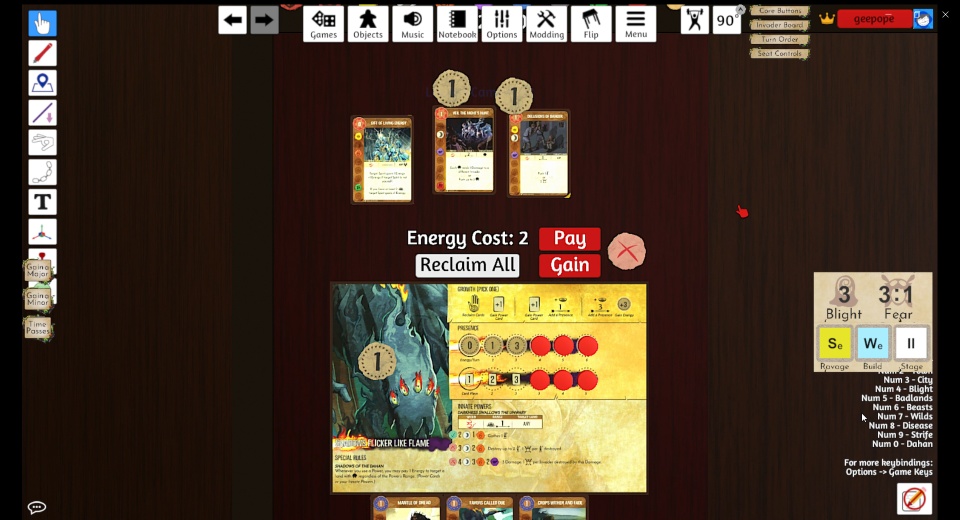
We immediately play Gift of Living Energy to give us the fire we need. We can use the offensive option on Veil the Night's Hunt to have the Dahan take care of the inland explorers. Our remaining cards are largely redundant, but Delusions of Danger can get us some easy fear (and the 2nd Moon for our innate) while saving our higher impact cards for later.
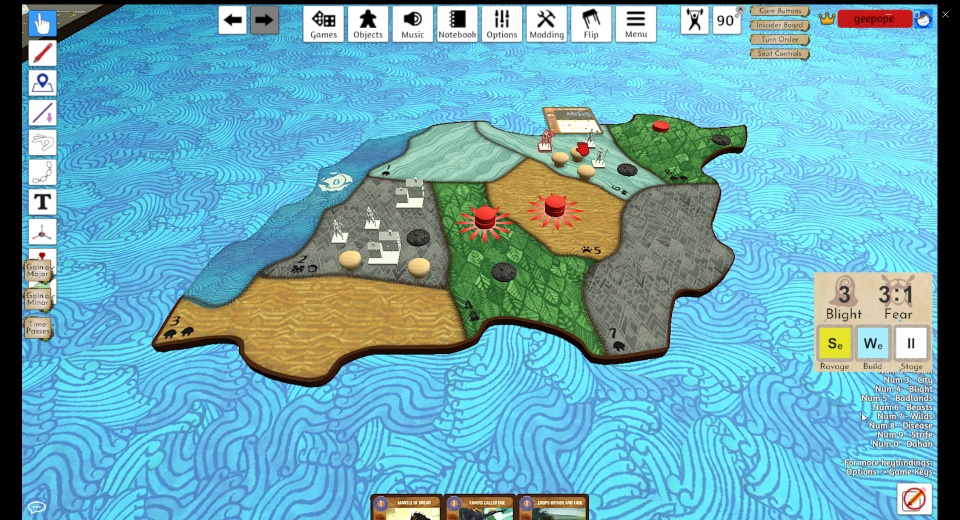
Putting our presence into the sands gives us a Sacred Site with reach into the inland wetland, letting us use our innate to gather in the coastal explorer. Veil the Night's Hunt does 1 damage per Dahan to different enemies, which will conveniently wipe out the explorers.
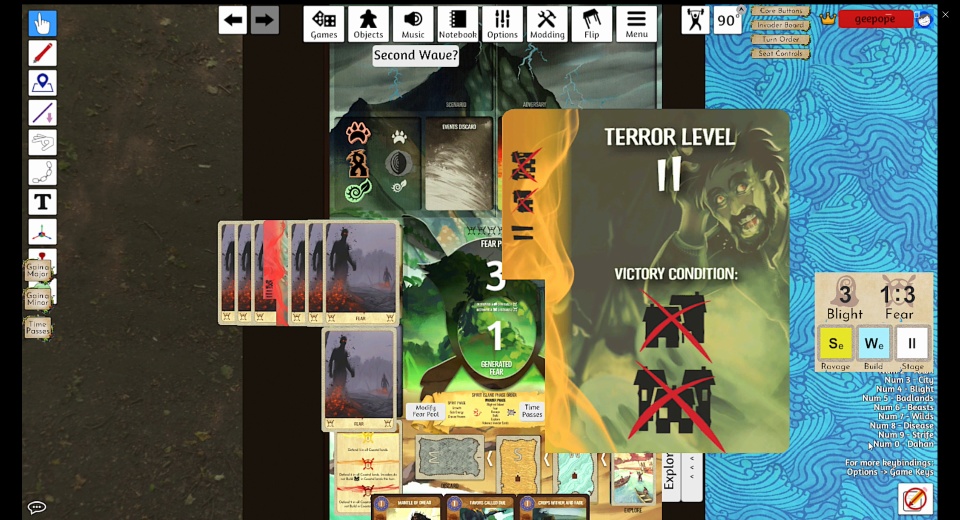
Meanwhile, we rack up 2 extra energy from Gift of Living Energy (since we have 2 sacred sites now) and 2 extra fear from Delusions of Danger. This puts us a third of the way through the fear deck, increasing the invaders' Terror Level. This gives us the more impressive 2nd level effects from future fear cards, and also changes our win condition: instead of having to wipe every last invader off the island, now we win as soon as all towns and cities are gone. At this point the explorers are too shaken to hang around and continue their attempts at colonization without support from larger settlements.
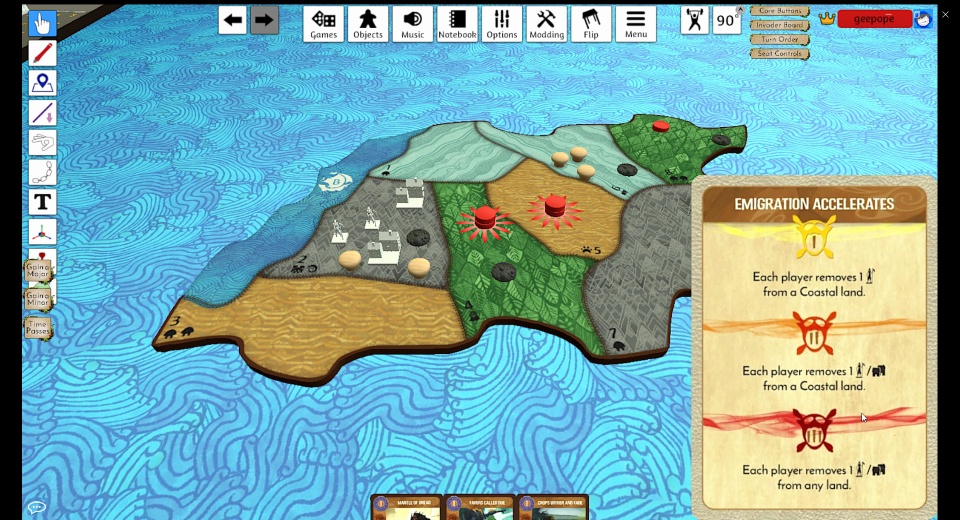
The newly boosted fear card can immediately take out one of the two remaining towns, putting us within a stone's throw of victory.
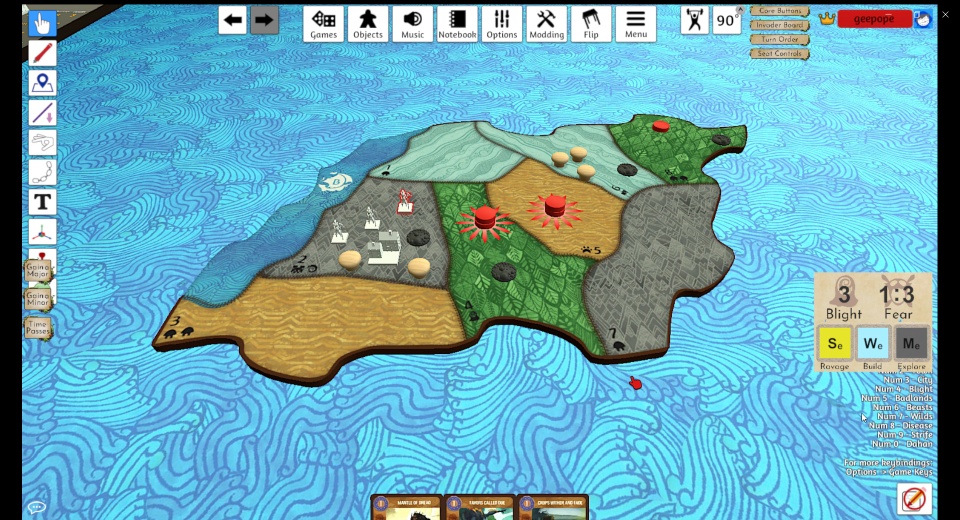
We get a free pass on both ravage & build this turn as neither sands nor wetlands are occupied, but the next terrain card flips as mountains. That might complicate our victory push as we don't have anything that can get rid of a town before they have a chance to build there, which means they'll be building a city.
We don't have anything to do in the slow phase, so it's time to grow. We've got 3 energy banked and another 3 coming, which we can easily increase to 4 with our next presence placement. That seems like an opportune time to try for a major power.

The first thing to notice is that major powers run way more expensive than minor powers. The second thing to notice is that every single major power comes with an elemental threshold, similar to the ones on our innate power. Major powers represent a more substantial shift in a spirit's nature than minor powers, so these open up new directions to focus your elements on. We can't hit any of the thresholds at the moment, although The Jungle Hungers has some overlap with our native elements and we could hit it with the cards in our discard.
Right off the bat there are three different ways to solve the impending mountain build->ravage cycle (and also the game):
Tsunami would easily wipe it out after it builds.
Paralyzing Fright would prevent it from building a city, leaving a town that I could deal with.
The Jungle Hungers can't do anything about the city before it gets built... but Crops Wither and Fade can, and The Jungle Hungers would take care of the rest.
Entwining Power is the odd man out here as a team-oriented support card, so we can safely ignore it.
Overall this is a really good draw. Even with draw 4 pick 1 you can't always count on finding something that will deal with your most immediate problem, let alone having your pick of options. The Jungle Hungers is a favorite of Shadows Flicker, so let's go that route.
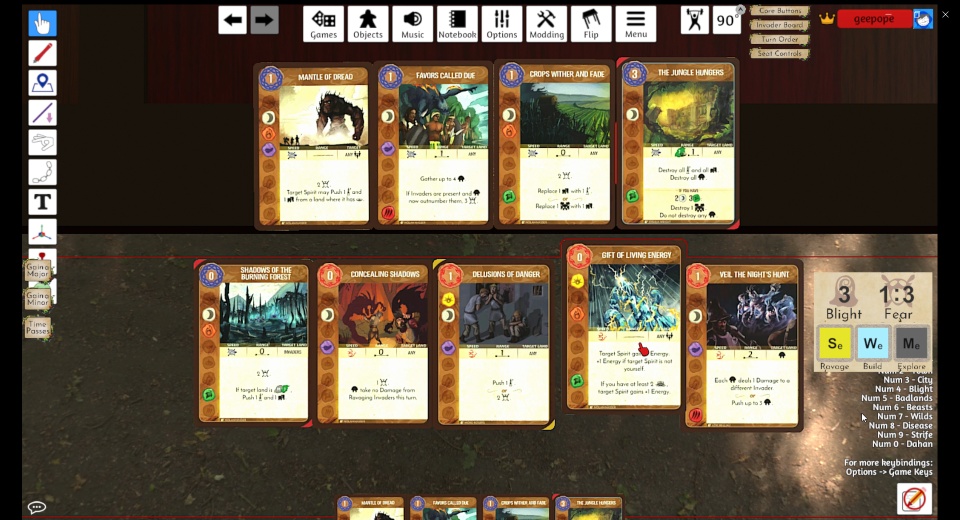
Picking up a major does require you to permanently forget one of your spirit's cards. You can forget from hand or discard, so generally it's to your advantage to forget from your discard so that you're not losing an immediately playable card. I jettison Gift of Living Energy, not that it particularly matters at this point.
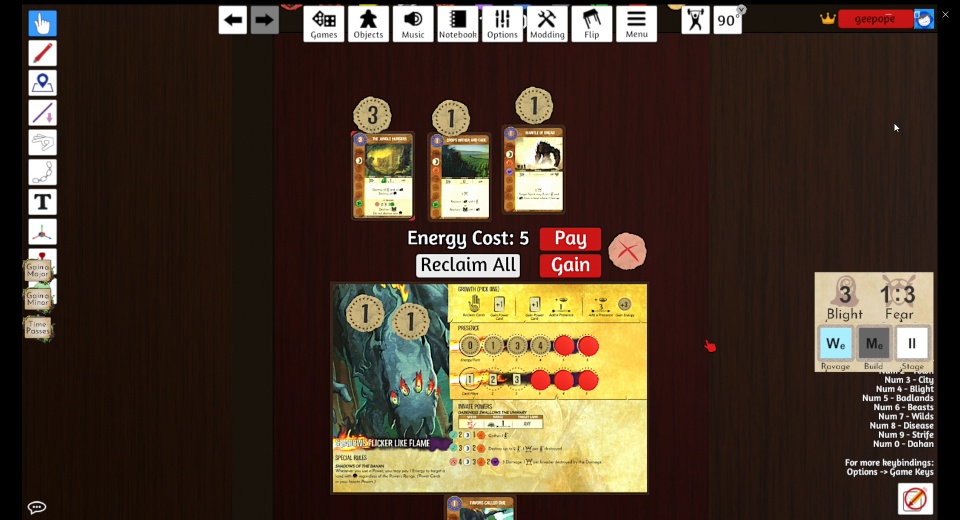
The Jungle Hungers + Crops Wither is enough to secure the victory at this point, but I throw in Mantle of Dread for the elements in order to show off the next level of my innate. Each threshold is cumulative and sequential, so for 3 Moon/2 Fire I can gather an explorer into a land and then destroy up to 2 explorers for fear in the same land I just gathered to.
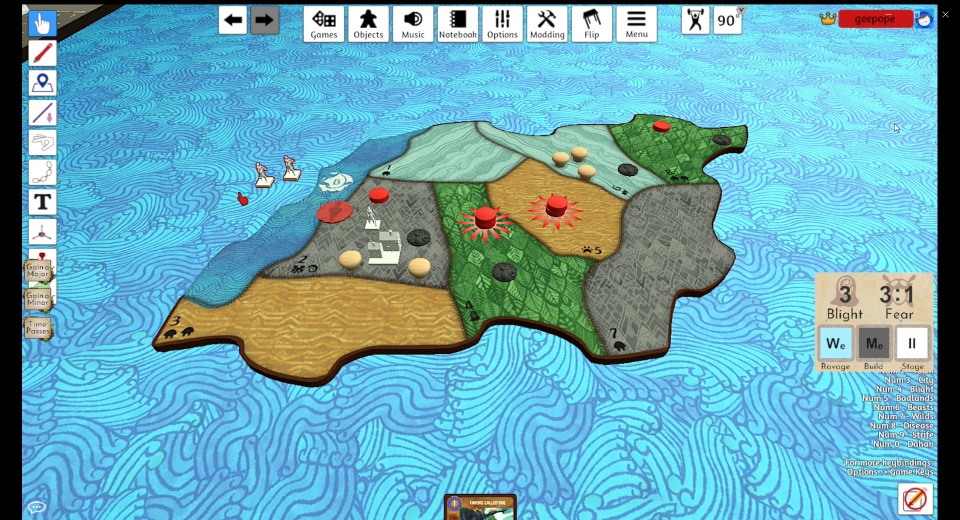
There's no additional explorers to gather regardless, so I just delete 2 explorers from the mountains and pick up a few fear.
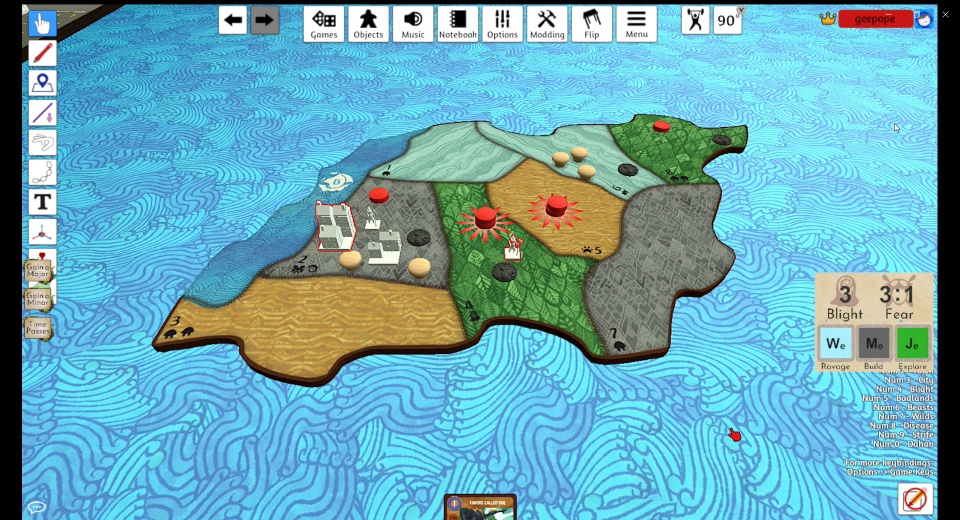
The invaders proceed to build a city on schedule, and an explorer sneaks into the jungle.
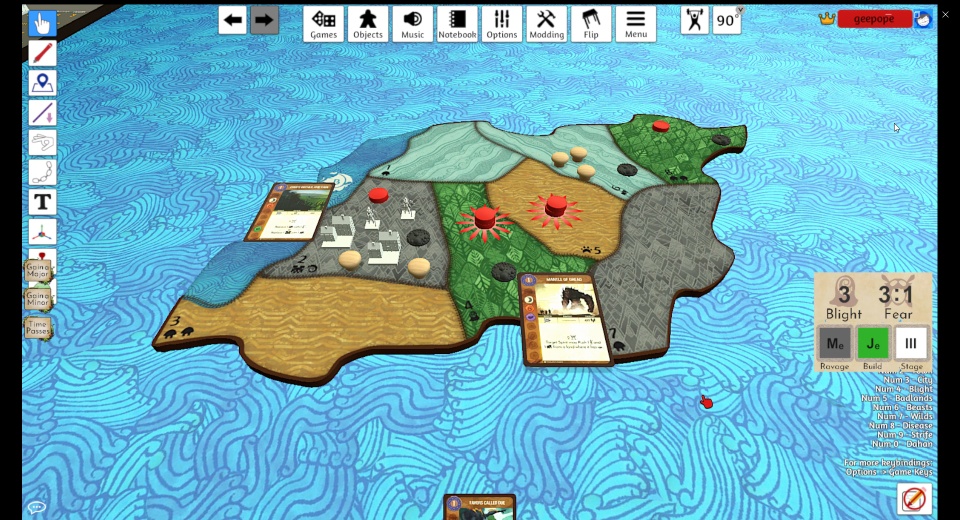
Mantle of Dread shoves the explorer back out, and Crops Wither replaces the last city with a mere town (they also earn 4 fear between the two of them to rack up another fear card, not that it matters at this point.)
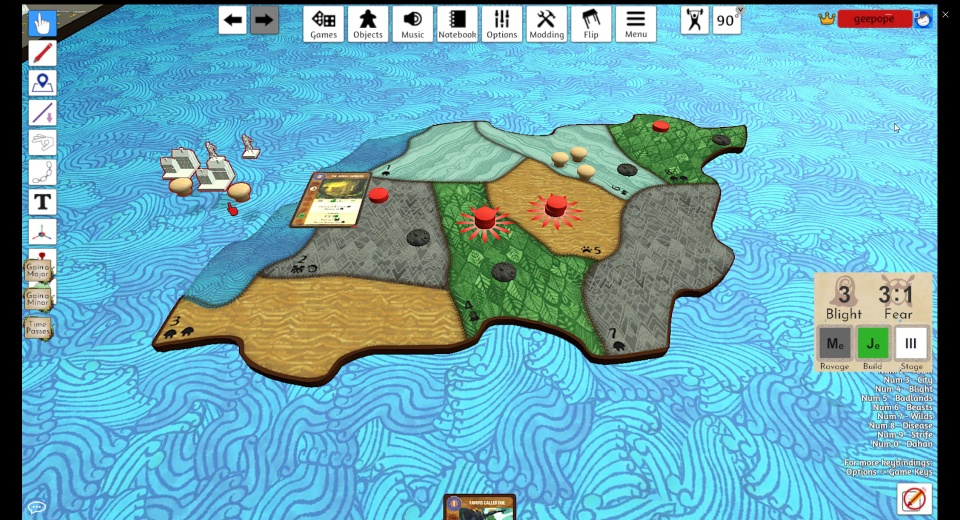
More importantly, this sets up the land to be wiped clear by The Jungle Hungers taking out every last explorer, town, and Dahan (sorry friends  ).
).
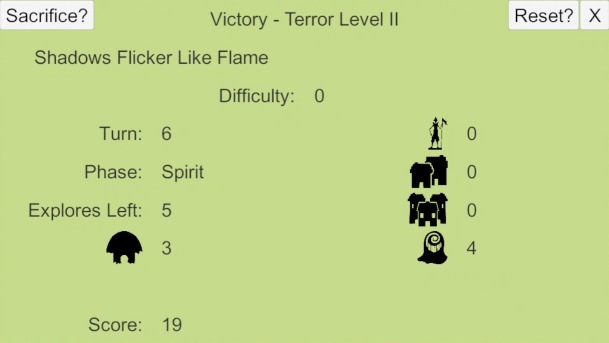
That's the game! The mod detects that the island is free of invaders and brings up a brief after action summary. Overall I certainly could have done better--this is usually not the recommended opening route for Shadows Flicker, but I figured it might be helpful for demonstration purposes. I also could have cut the game very marginally shorter with a little help from these guys:
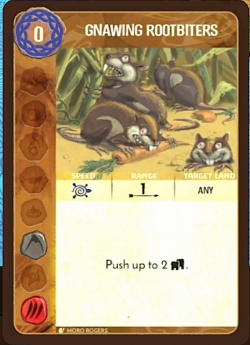
Last turn I could have skipped my innate and played Gnawing Rootbiters + Favors Called Due + Delusions of Danger, using Delusions to skinny down the explorer pile in the inland wetlands and Rootbiters to shovel the remaining mountain towns into the wetland where Favors Called Due could get me a big pile of Dahan. Then all I would have had to do this turn would be to reclaim and play Concealing Shadows so that all the towns would be wiped out by the big wetlands ravage + counterattack for an easy Terror Level II victory before the mountains even had a chance to build. If you care about playing for "score" there is a score displayed under "Show details" that based in part on how many cards are left in the invader deck, so if you can hit a win condition during the ravage you get a couple extra points over waiting for slow phase (since the invaders will have explored another card by then.)
I could claim that I wanted to deliberately drag the game out to show off major powers, but I honestly just didn't see the move at the time. It's an important lesson in not letting yourself get too blinded by your innate elements: while it's generally a good idea to draft for elements early on to maximize your options later, as you approach the endgame you should focus more on what elements do for you right now and whether that's worth it compared to juicier off-element effects. In my defense, I'm used to playing at higher difficulties and would not normally be looking for opportunities to finish off the game this early.
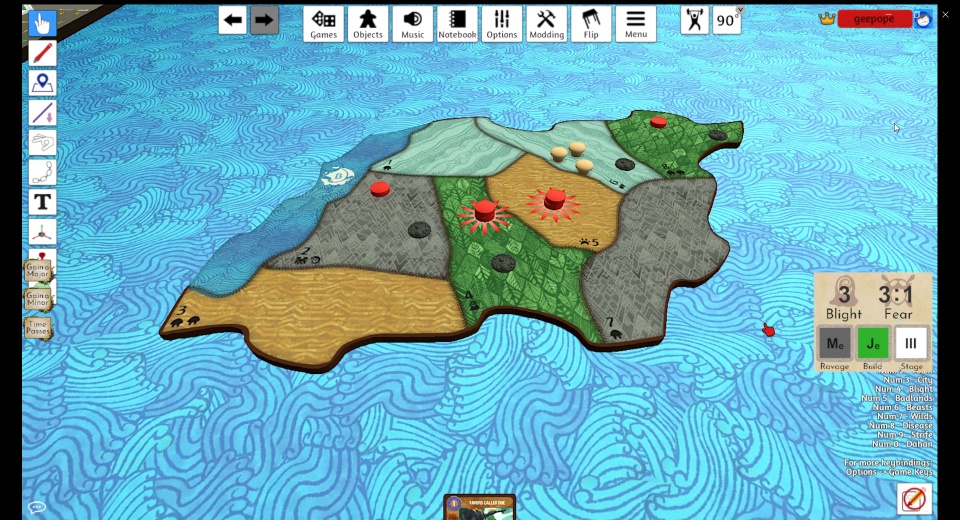
Our peaceful island. The colonists did a number on the island and its Dahan population (or at least we're chalking it all up to the colonists), but both of them will recover in time. The island's reputation will keep invaders away for a good long while, and the spirits that make the island unique will be able to continue existing.
Overall, playing at the introductory level is easy enough once you know what you're doing. The steepest part of the game's learning curve is dealing with slow actions: it's quite common as a new player to find yourself saying "oh good, I've got a meaty slow power to throw at that town that's about to build" only to realize that oops, there's now a city there and the power you had earmarked to deal with that land is now entirely inadequate. There are a ton of modular difficulty options and they're certainly not all going to be this easy, but it's not bad for a start.













































 ).
).


